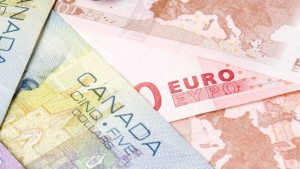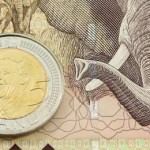 Yesterday’s trade saw EUR/CAD within the range of 1.3961 – 1.3815. The pair closed at 1.3883, up 0.14% for the day.
Yesterday’s trade saw EUR/CAD within the range of 1.3961 – 1.3815. The pair closed at 1.3883, up 0.14% for the day.
At 07:26 GMT today EUR/CAD was down 0.32% for the day to trade at 1.3844. The pair held in a daily range of 1.3836 – 1.3927 and is down 0.3% for the week so far.
Fundamentals
Eurozone
Producer prices in Germany fell at the annualized rate of 1.3% in May, Destatis reported at 06:00 GMT, compared to a 1.5% deflation in April. This was the fourth straight month of improvement after a -2.2% decline recorded in January, which was the lowest in five years. Month-on-month, the producer price index was flat, missing projections of a 0.2% jump following three straight months of slower-than-expected 0.1% growth.
The Producer Price Index measures changes in prices of goods and services either as they leave the production process, or as they enter it. Unlike the CPI, which measures price changes from the consumers perspective, the PPI basically gauges the prices received by domestic producers for their output, or the prices paid by domestic producers for their intermediate inputs. The PPI performance may be an early signal for inflationary pressure in the economy. Generally speaking, a higher-than-expected PPI reading should be considered as having a bullish effect on the common currency, as it suggests accelerated consumer inflation, while a lower-than-expected result would have a bearish effect.
Meanwhile, the surplus on the Eurozones seasonally adjusted current account probably narrowed to EUR 18.1 billion in April from EUR 18.6 billion in March.
The regions current account (without a seasonal adjustment) produced a surplus at the amount of EUR 24.9 billion in March and is likely to have narrowed to EUR 21.2 billion in April. An all-time high surplus was registered at EUR 35.20 billion in December 2014.
The current account reflects the difference between savings and investments in the Euro area. It is the sum of the balance of trade, net current transfers (cash transfers) and net income from abroad (earnings from investments made abroad plus money sent by individuals working abroad to their families back home, minus payments made to foreign investors).
A current account surplus indicates that the net foreign assets of the region have increased by the respective amount, while a deficit suggests the opposite. A country/region with a surplus on its current account is considered as a net lender to the rest of the world, while a current account deficit puts it in the position of a net borrower. A net lender is consuming less than it is producing, which means it is saving and those savings are being invested abroad, or foreign assets are created. A net borrower is consuming more than it is producing, which means that other countries are lending it their savings, or foreign liabilities are created. A contracting surplus or an expanding deficit on the areas current account usually has a bearish effect on the euro.
The European Central Bank is expected to release the official data at 9:00 GMT.
Canada
Annualized consumer inflation in Canada is expected to come in at 0.8% in May, Statistics Canada will report at 12:30 GMT, matching Aprils reading which was the lowest since October 2013s 0.7% price growth. Cheaper energy continued to be the main source of pressure as gasoline prices were down 21.0% in April from a year earlier, while natural gas slid 14.6% after a 0.4% increase a month earlier. In monthly terms, consumer prices probably grew 0.5% after a 0.1% contraction in April.
Key categories in the Canadian CPI basket are Shelter (accounting for 27.5% of the total weight) and Transportation (19.3%). Other categories include Food (with a 16.1% share), Household Operations, Furnishings and Equipment (11.8%), Recreation, Education and Reading (11.8%), Clothing and Footwear (5.7%), Health and Personal Care (5%), while Alcoholic Beverages and Tobacco Products comprise the remaining 3%.
Bank of Canadas (BoC) annualized Core CPI, which excludes prices of fruits, vegetables, gasoline, fuel oil, natural gas, mortgages, intercity transportation, and tobacco products, will probably register at 2.1% in May from 2.3% in April. This is the key measure of inflation, on which the central bank bases its decisions regarding monetary policy. In monthly terms, core CPI is expected at 0.3%. A better-than-expected reading would be CAD positive, and vice versa.
The statistics agency will also report that retail sales in Canada probably rose 0.7% in April on a monthly basis, following another 0.7% gain in March. Retail sales are the foremost indicator of consumer spending, which accounts for the majority of economic activity. The index is considered as a coincident indicator, thus it reflects the current state of the economy, and is also deemed a pre-inflationary indicator.
Retail sales, excluding sales of automobiles, probably grew 0.3% in April, which would be a third monthly expansion. Large-ticket purchases are excluded due to their high volatility, which could influence the general trend. In case retail sales rose more than anticipated, this would support the Canadian dollar, and vice versa.
Pivot points
According to Binary Tribune’s daily analysis, the pair’s central pivot point stands at 1.3886. In case it penetrates the first resistance level at 1.3958, it will encounter next resistance at 1.4032. If breached, upside movement may attempt to advance to 1.4104.
If the cross drops below its S1 level at 1.3812, it will next see support at 1.3740. If the second key support zone is breached, downward movement may extend to 1.3666.
In weekly terms, the central pivot point is at 1.3891. The three key resistance levels are as follows: R1 – 1.4042, R2 – 1.4198, R3 – 1.4349. The three key support levels are: S1 – 1.3735, S2 – 1.3584, S3 – 1.3428.





